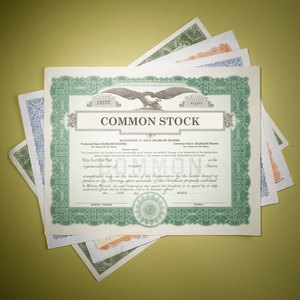
If you own stock, you'll want to occasionally check the rate of your return. If you're a business with stockholders, you'll also want to track this information. The rate of return on common stock equity indicates how well a company uses investment capital from its shareholders to generate revenue. A high rate of return on common stock illustrates that a company is effectively using investments made by its common stockholders. A company must compare its rate of return on common stock to other businesses in the same industry to get an accurate assessment of its financial health. The rate of return on common stock is calculated by dividing a company’s net income by the average common stockholders’ equity.
Tips
In order to calculate the rate of return on common stock equity, you can divide the net income by the average common stockholder equity. This fractional result can then be multiplied by 100 to convert it into a percentage value.
Research Your Stock Information
To get started, you'll need the income sheet for the stock in question. Locate the net income on that income statement. Net income indicates the profit generated by a business during a 12-month period. A company’s net income illustrates the profit a company makes after expenses, losses and income taxes. Net income gets transferred to the stockholders’ equity section of the balance sheet. A company will either reinvest net income in the form of retained earnings, or distribute them to shareholders in the form of dividends.
Observe the stockholders’ equity section of the balance sheet. Assume a company has not issued any preferred shares. This means all stock issued by the company is common stock. Stockholders’ equity indicates the amount of capital shareholders have invested in the business. A company can calculate stockholders’ equity by subtracting total liabilities from total assets. Compare the company’s stockholders’ equity balance at the beginning of the year to its stockholders' equity at the end of the year.
Calculate the Rate of Return
Add the beginning stockholders’ equity with the ending stockholders’ equity amount. For instance, a company with $100,000 beginning stockholders’ equity and $150,000 ending stockholders’ equity has stockholders’ equity of $250,000. Divide $250,000 by two to determine the average stockholders’ equity. In this case, average common stockholders’ equity is $125,000.
Divide net income by average common stockholders’ equity. Assume a company has net income of $40,000 and average common stockholders’ equity of $125,000. In this scenario, a company’s rate of return on common stock equity equals 0.32 or 32 percent. This information will help you make whatever decisions you need to make moving forward, but you'll still need to periodically check this information, since it will change.
References
- Required Rate of Return - Definition and How to Calculate
- Motley Fool: How to Calculate Rate of Return on Common Stock Equity
- Accounting For Management: Return on common stockholders’ equity ratio
- U.S. Securities and Exchange Commission. "Beginners' Guide to Financial Statement." Accessed July 6, 2020.
- Nasdaq. "Paid-In Capital." Accessed July 6, 2020.
- Nasdaq. "Retained Earnings." Accessed July 6, 2020.
- Financial Accounting Standards Board. "Statement of Financial Accounting Standards No. 130," Page 38. Accessed July 6, 2020.
- U.S. Small Business Administration. "5 Things to Know About Your Balance Sheet." Accessed July 6, 2020.
- U.S. Securities and Exchange Commission. "How to Read a 10-K." Accessed July 6, 2020.
Writer Bio
Christopher Carter loves writing business, health and sports articles. He enjoys finding ways to communicate important information in a meaningful way to others. Carter earned his Bachelor of Science in accounting from Eastern Illinois University.

